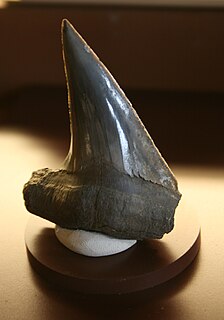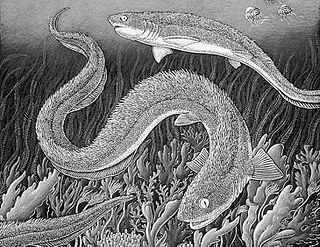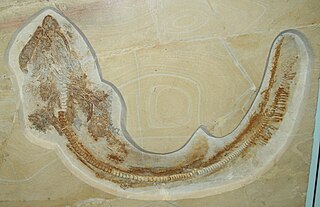 W
WThe Anacoracidae are an extinct shark family in the order Lamniformes. They lived throughout the prehistoric oceans during the Cretaceous period. The most numerous and well-known member of this family is Squalicorax, which was one of the most common marine predators during the period. Formerly, other shark genera such as Pseudocorax and Galeocorax were considered to belong to this family, on the basis of their similar teeth; however, a 2012 revision by Henri Cappetta moved these sharks into their own family, the Pseudocoracidae.
 W
WAquilolamna is an extinct genus of shark-like elasmobranch from the Late Cretaceous (Turonian)-aged Agua Nueva Formation of Mexico. It is currently known to contain only one species, A. milarcae, also known as the eagle shark, and it is classified in its own family Aquilolamnidae, which has been tentatively assigned to the mackerel sharks.
 W
WCladoselachidae is an extinct family of holocephalian cartilaginous fishes closely related to Symmoriiformes. They are the only members of the order Cladoselachiformes and were characterized by having an elongated body with a spine in each of the two dorsal fins.
 W
WCretoxyrhina is an extinct genus of large mackerel shark that lived about 107 to 73 million years ago during the late Albian to late Campanian of the Late Cretaceous. The type species, C. mantelli, is more commonly referred to as the Ginsu shark, first popularized in reference to the Ginsu knife, as its theoretical feeding mechanism is often compared with the "slicing and dicing" when one uses the knife. Cretoxyrhina is traditionally classified as the likely sole member of the family Cretoxyrhinidae but other taxonomic placements have been proposed, such as within the Alopiidae and Lamnidae.
 W
WCtenacanthidae is an extinct family of prehistoric sharks in the order Ctenacanthiformes. Species of the different genera are found in strata ranging from Devonian to Triassic, with a worldwide distribution.
 W
WGregoriidae is an extinct family of early sharks from the Carboniferous period. It currently includes three described genera: Gregorius, Srianta, and Bealbonn. This family includes remains formerly ascribed to "Desmiodus," which is now considered a nomen vanum. The relationships between the included genera are not entirely clear. Fossils are known from Serpukhovian-aged formations including the Bear Gulch Limestone and Surprise Canyon Formation.
 W
WHybodontidae is an extinct family of sharks that first appeared in the Mississippian period and disappeared at the end of the Late Cretaceous.
 W
WListracanthidae is a proposed family of extinct cartilaginous fish. It currently includes the genera Listracanthus and Acanthorhachis. This clade is likely included within Elasmobranchii, but its placement within it is uncertain. Both genera are known from their distinctive spiny dermal dentictles which coat the exterior of their long, slender bodies. They are known from the Viséan to the Early Triassic, mainly from what is now the northern hemisphere. However, there is a possible occurrence in Australia.
 W
WMcmurdodus is an extinct genus of sharks and the sole member of the family Mcmurdodontidae, in the order Hexanchiformes. It contains two extinct species.
 W
WOrodontidae is an extinct family of cartilaginous fish that lived from the late Pennsylvanian to the Early Permian in what is now North America.
 W
WOrthacodontidae is an extinct family of sharks in the order Synechodontiformes. It contains twelve species within three genera. Some authors included it into Hexanchiformes or Lamniformes.
 W
WPaleospinacidae is an extinct family of prehistoric sharks in the extinct order Synechodontiformes.
 W
WPetalodontidae is an extinct family of marine cartilaginous fish related to modern day chimaera found in what is now the United States of America and Europe. With a very few exceptions, they are known entirely from teeth. All fossils range from the Carboniferous to the Permian, where they are presumed to have died out during the Permian/Triassic extinction event.
 W
WPtychodontidae is a family of extinct neoselachian sharks which lived from the Cretaceous to the Paleogene.
 W
WSymmoriidae is an extinct family of holocephalians from the Devonian and Carboniferous periods.
 W
WXenacanthidae is a family of prehistoric sharks in the order Xenacanthida.